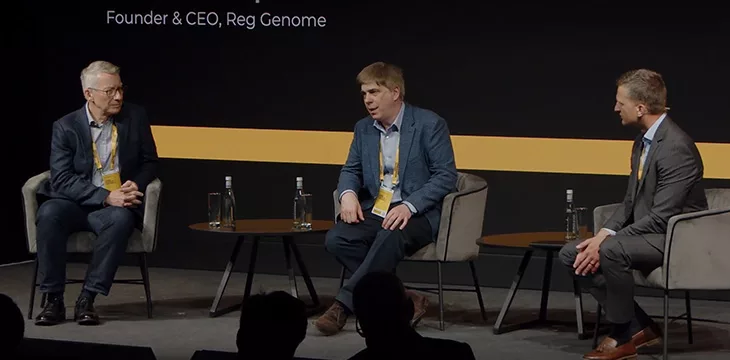|
Getting your Trinity Audio player ready...
|
A London Blockchain Conference 2024 panel discussion on May 21 heard that “human-intensive systems in…compliance departments are no longer fit for purpose,” and the future of regulatory compliance lies in computational regulatory databases, or rules engines, designed to meet the challenges of smart contract powered fintech.
At the London Blockchain Conference 2024 ‘Insight stage,’ attendees glowing with satisfaction only gourmet food trucks can provide took their seats to ‘peer into tomorrow,’ with the panel titled “Can we embed computational compliance in the fabric of financial technology infrastructure?”
In keeping with one of the key themes of conference, the panel explored frontiers in tech innovation. In this case, the feasibility and implications of integrating compliance into fintech and how financial systems can evolve to become more secure, transparent, and efficient by leveraging computational tools at their core.
Our host for the discussion was Patrick Prinz, founder of fintech startup Monetix and former COO of nChain, known for being the largest IP holder in the blockchain space.

Prinz began by outlining the issue at hand, namely the weight of financial regulation that makes it prohibitively expensive for small tech innovators around the globe to become compliant and participate in the space—or, as Robert Wardrop more succinctly summarized: “Human-intensive systems in your compliance departments are no longer fit for purpose.”
Wardrop is a professor at the University of Cambridge Business School and founder & CEO of Reg Genome, a Cambridge-based provider of financial regulatory services. Together with Gavin Ferris, co-founder and board chair of zeroRISC—a commercial cloud security service for silicon that claims to be delivering “transparency and trustworthiness for data centers and ICS/OT, IoT and edge devices”—the pair are helping develop a “rules engine,” that will assist, and potentially make obsolete, traditional compliance departments.
This “computational regulatory database,” says Wardrop, would translate regulation and regulatory obligations into a machine-readable and operational form and function better than any human in a smart contract environment.

Ferris agreed, adding that “having secure execution environments that you can really believe in is crucial,” a goal that is “all about provenance,” he said.
But, as much as its utility might seem obvious, a regulatory rules engine is not without its critics.
Wardrop explained that regulators don’t like the idea of their policy documents being misinterpreted or taken out of context, and so a platform, such as Reg Genome, needs to provide assurances that they are transmitting the provenance and authenticity of the regulation.
In other words, regulators want peace of mind that any computational regulations will demonstrate the “lineage” of the regulation to a specific document.
The immutability of the blockchain provides a potential solution to this point of contention with regulators, and Ferris suggested that zeroRISC provides the infrastructure security needed for the process.
“At the end you have a log that says the data is reliable and trustworthy,” said Ferris. “The regulatory part has to be smart, the data that feeds it has to be believable, there has to provenance… if you have that, you stand a good chance of success.”
He added that “this is not science fiction; the pieces all exist.”

Prinz chimed in to ask the panellists what other benefits this technology might provide, to which Wardrop responded, “I don’t think anybody thinks the financial system is cost effective, and secondly it’s about accessibility.”
Financial inclusion, agreed Ferris, is one of the ultimate goals of this kind of technology. Alleviating the burden of people-power and the costs of regulatory compliance work from small financial sector businesses and innovators around the globe, particularly in the developing world.
On this aspirational note, Prinz concluded the discussion by asking the speakers for their visions for the future of technology.
Ferris reiterated that “the plumbing is there… all the regulatory scraping exists, smart contracts exist… so I feel this is closer than people think, and the needs are very high. It will happen; it’s inevitable.”
He concluded that little by little, “regulation is transforming itself into a technology”—a potentially monumental change from a status quo where regulation existed to govern technology.
Likewise, Wardrop assured the London Blockchain Conference 2024 audience that “it’s going to be an interesting five years.” He finished by predicting that the process of change towards a computational compliance infrastructure will be accelerated, and the “wallets will open up” when the private sector pressure forces the issue with regulators and authorities and that this will happen in the next couple of years.
Watch: It’s time for regulation to enable blockchain growth

 07-06-2025
07-06-2025 





